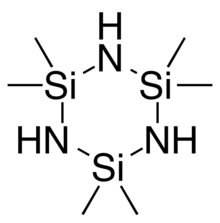Hexamethylcyclotrisilazane
Hexamethylcyclotrisilazane[3] is a chemical compound with formula C
6H
21N
3Si
3 or [–Si(CH
3)
2–NH–]
3. Its molecule consists of a six-member ring of three silicon atoms alternating with three nitrogen atoms, with two methyl groups bonded to each silicon and one hydrogen atom bonded to each nitrogen. It can be described as a derivative of the hypothetical compound cyclotrisilazane [–SiH
2–NH–]
3, or as a cyclic trimer of hypothetical dimethylsilazane (CH
3)
2SiNH.[2][4]
 | |
| Names | |
|---|---|
| Other names
2,2,4,4,6,6-hexamethyl-1,3,5,2,4,6-triazatrisilinane; 1,1,3,3,5,5-hexamethyl-2,4,6,1,3,5-triazatrisilinane; 2,4,4,6,6-hexamethyl-1,3,5-triaza-2,4,6-trisilacyclohexane; dimethylsilazane trimer; HMCTS; HCMTSZ | |
| Identifiers | |
3D model (JSmol) |
|
| ChEMBL | |
| ChemSpider | |
| ECHA InfoCard | 100.012.521 |
| EC Number |
|
PubChem CID |
|
| UNII | |
CompTox Dashboard (EPA) |
|
| |
| |
| Properties | |
| C6H21N3Si3 | |
| Molar mass | 219.510 g·mol−1 |
| Density | d20 0.9196 g/mL [1] |
| Melting point | −10 °C [1][2] |
| Boiling point | 188 °C [1][2] |
Refractive index (nD) |
n20/D 1.445 [1] |
| Hazards | |
| GHS pictograms |    |
| GHS Signal word | Danger |
GHS hazard statements |
H226, H302, H314, H315, H318, H319, H335 |
| P210, P233, P240, P241, P242, P243, P260, P261, P264, P270, P271, P280, P301+312, P301+330+331, P302+352, P303+361+353, P304+340, P305+351+338, P310, P312, P321, P330, P332+313, P337+313, P362 | |
| Flash point | 59 °C; 139 °F; 333 K |
Except where otherwise noted, data are given for materials in their standard state (at 25 °C [77 °F], 100 kPa). | |
| Infobox references | |
The compound is a clear colorless liquid at room temperature.[2]
The compound has been extensively studied because of its applications in the semiconductor industry, as a precursor for the deposition of fils of silicon nitride[5][6][7] and silicon carbonitride[8] and as an additive in photoresist formulations. It has also been proposed as an additive to silica for liquid chromatography.[9]
Other names for the compound are 2,2,4,4,6,6-hexamethyl-1,3,5,2,4,6-triazatrisilinane (IUPAC), 1,1,3,3,5,5-hexamethyl-2,4,6,1,3,5-triazatrisilinane, and 2,4,4,6,6-hexamethyl-1,3,5-triaza-2,4,6-trisilacyclohexane.[2] The name is often abbreviated HMCTS[3] or HMCTSZN.[7]
Structure
The silicon-nitrogen ring is nearly planar. The interatomic distances are: Si-N = 1.728 Å, Si-C = 1.871 Å, C-H = 1.124 Å. The approximate bond angles are N-Si-N ≈ 108°, Si-N-Si ≈ 127°, C-Si-C ≈ 109°, H-C-H ≈ 112°.[10][11]
Synthesis
The compound was obtained in 1948 by Brewer and Haber by introducing dimethyldichlorosilane Si(CH
3)
2Cl
2 into liquid ammonia NH
3, and then extracting the precipitate with benzene. The reaction yields a mixture of compounds, chiefly the trimer and the tetramer octamethyltetrasilazane. The trimer can be separated from the other products by fractional distillation.[1]
The yield can be improved by converting the tetramer, through reaction with hydrogen in the presence of suitable catalysts.[12][13]
Toxicity
The 50% lethal dose (LD50) for rats is 500 mg per kg of body mass.[2]
References
- Stuart D. Brewer and Charles P. Haber (1948): "Alkylsilazanes and Some Related Compounds". Journal of the American Chemical Society, volume 70, issue 11, pages 3888-3891. doi:10.1021/ja01191a106
- NCBI, U.S. National Institutes of Health (2020): "2,2,4,4,6,6-Hexamethylcyclotrisilazane". Compound data sheet, PubChem online database. Accessed on 2020-01-04.
- FAR Chemical (2020): "Product 654201: Hexamethylcyclotrisilazane". Catalog page. Accessed on 2020-01-04.
- Beilstein 4 III 1887.
- Dennis W. Hess and Todd A. Brooks (1987): "Plasma enhanced chemical vapor deposition of thin films of silicon nitride from cyclic organosilicon nitrogen". United States Patent 4863755A.
- T. A. Brooks and D. W. Hess (1987): "Plasma-enhanced chemical vapor deposition of silicon nitride from 1,1,3,3,5,5-hexamethylcyclotrisilazane and ammonia". Thin Solid Films, volume 153, issues 1–3, pages 521-529. doi:10.1016/0040-6090(87)90211-2
- T. A. Brooks and D. W. Hess (1988): "Deposition chemistry and structure of plasma‐deposited silicon nitride films from 1,1,3,3,5,5‐hexamethylcyclotrisilazane". Journal of Applied Physics, volume 64, page 841. doi:10.1063/1.341935
- N. I. Fainer, A. N. Golubenko, Yu. M. Rumyantsev, and E. A. Maximovskii (2009): "Use of hexamethylcyclotrisilazane for preparation of transparent films of complex compositions". Glass Physics and Chemistry, volume 35, issue 3, pages 274–283. doi:10.1134/S1087659609030067
- J. Nawrocki (1985): "Modification of silica with mixtures of hexamethylcyclotrisilazane and hexamethyldisilazane". Chromatographia´ volume 20, pages 308–312. doi:10.1007/BF02310388
- Béla Rozsondai, István Hargittai, Aleksei V. Golubinskii, Lev V.Vilkov, and Vladimir S.Mastryukov (1975): "Electron diffraction study on the molecular structure of hexamethylcyclotrisilazane, [(CH
3)
2SiNH]
3". Journal of Molecular Structure, volume 28, issue 2, pages 339-348. doi:10.1016/0022-2860(75)80104-9 - D. M. Adams and W. S. Fernando (1973): "The vibrational spectra of hexamethylcyclotrisiloxane and hexamethylcyclotrisilazane". Journal of the Chemical Society, Dalton Transactions, issue 4, pages 410-413.doi:10.1039/DT9730000410
- Hiromi Ohsaki, Yoshihumi Takeda, Toshinobu Ishihara, and Akira Hayashida (1991) "Method for preparing hexamethyl cyclotrisilazane". United States Patent 5075474A
- Barry C. Arkles and Burrell N. Hamon (1985): "Method of preparing hexamethylcyclotrisilazane" United States Patent 4577039A.